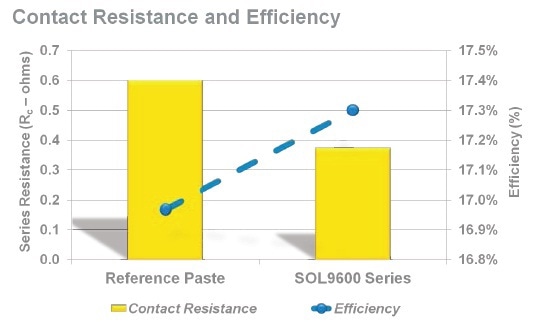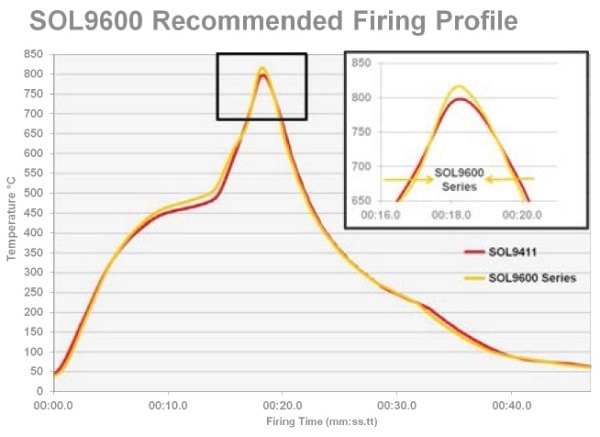The SOL9600 Series is Heraeus' new generation of front-side pastes for c-Si solar cells, which focuses on two critical technical needs of cell manufacturers that include improved efficiency and lower paste usage per cell.
Heraeus SOL9600 Series is developed for finer line screen printing on mono and multicrystalline silicon solar cell wafers than previous generations of pastes. It has a lower and uniform contact resistance resulting in a higher fill factor thereby higher cell efficiency. Customers that use the SOL9600 Series have demonstrated up to 0.3% absolute efficiency improvements and finer line printability. These benefits improve the profitability of PV cells.
Key Benefits
The key benefits of the SOL9600 are:
- Significant improvement of contact quality on emitters and wafers up to 100 O/square
- Higher efficiency – up to 0.3% absolute
- Finer line resolution
- Excellent solderability
- Cd free
Typical Properties
Viscosity
Cone and Plate Viscometer (Brookfield, HBT)
- 140 – 220kcps
- CPE-51 spindle, @ 1RPM, 25°C
Solids
90.5 ± 1%
Solderability
- 5 second dip @ 230°C
- Sn62, SAC305
- Use with low solids, no clean flux
Improved Contact Resistance
Heraeus’ SOL9600 Series provides higher efficiency for solar cells due to its significantly improved contact resistance. Our R&D scientists have developed paste compositions that reduce the glass interface between the pastes and wafer after firing as shown in Figure 1.

Figure 1. SOL9600 Series exhibits less glass in the interface between the paste and wafer.
Reduced contact resistance is one component of the SOL9600 Series’ overall lower series resistance. Figure 2 shows the reduction in series resistance relative to the company’s other high performance pastes. This improvement in series resistance correlates up to a 0.3% higher cell efficiency when using SOL9600 Series of pastes for solar cells.

Figure 2. Test show that SOL9600 Series has over a 35% reduction in series resistance and up to a 0.3% absolute efficiency improvement over our other industry leading pastes.
Recommended Processing Guidelines
Printing guidelines are provided in Table 1.
Table 1. Printing guidelines
| Design Finger Line Opening |
Screen Parameter Recommendations |
| 50 - 70µm |
290, C290 mesh, 20µm stainless steel wire, 15 – 20µm EOM
400 mesh, 18µm stainless steel wire, 15 – 20µm EOM |
| 50 - 70µm |
V330 mesh, 23µm polymer wire, 15 – 20µm EOM |
| Squeegee |
70 - 75 Shore |
| Squeegee Speed |
≥ 180mm/sec |
| Squeegee Pressure |
60 – 90N |
| Off-contact Distance |
1.0 – 1.2mm |
| Flood Speed |
≥ 300mm/sec |
Drying - Typically dried in an IR dryer with set points of 250-300°C in less than 20 seconds or 150°C for 10 minutes in circulated air oven.
Firing – Firing profile is shown in Figure 3.

Figure 3. Firing profile
Line Resolution (finger width) - 50 - 70µm
Thinner - RV-354
Storage - Store in a dry location at 5°C – 25°C.
About Heraeus Photovoltaics
The Heraeus Photovoltaics Business Unit is an industry leading developer and manufacturer of metallization pastes for the photovoltaic industry.
Heraeus has been a manufacturer of thick film pastes for over 40 years. Since 2008, we have been an innovative supplier to the photovoltaics industry, working with c-Si cell manufacturers to improve their cells’ efficiency for both conventional and advanced cell designs.
Heraeus have developed silver metallization pastes that have been integrated into commercially available technologies such as MWT, Double Print, Dual Printing, Selective Emitter, Back Side Passivation and N-Type Cells.
Heraeus have also expanded our capabilities and developed lower temperature processing pastes for Thin Film and other c-Si technologies.
Heraeus' goal is to improve our customers’ cell efficiency and reduce their cell’s cost per watt through our innovative paste design technology.

This information has been sourced, reviewed and adapted from materials provided by Heraeus Photovoltaics.
For more information on this source, please visit Heraeus Photovoltaics.